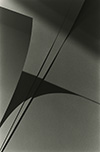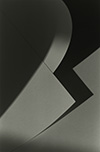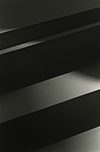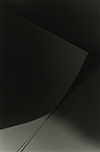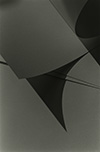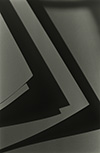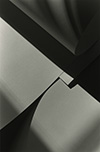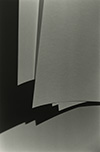last exhibition
68th Street 光の記憶 - Yoshihiko Ueda
Weekdays 11:00 - 20:00
Weekends and Holidays 11:00 - 18:30
Mondays and Tuesdays Closed
Entrance Fee 800 yen for over 18

commentary
291, 916: A Japanese Place
清水 穣(美術評論家)
「68th Street 光の記憶」は、2012年2月10日にオープンしたギャラリー916の活動を締めくくる最後の展覧会として構想されている。その構想とはどのようなものだろうか。
そもそもギャラリーがオープンしたとき、その3桁の数字の名前、しかも91という数を見て、アルフレッド・スティーグリッツ(1864-1946)の291ギャラリー(5番街291番地;1908-1917)を想起しなかった人はいないだろう(916がたんに写真家上田義彦の誕生日9月16日から採られたとしても)。そしてその連想とともに本展を見れば、ところどころにスティーグリッツへの、とりわけそのイクイヴァレントのシリーズへの示唆が見られる。光の記憶は、ニューヨーク68丁目の小さなアパートに差し込む光の記憶にとどまらず、同じニューヨークで生涯を過ごしたスティーグリッツの記憶であり、すなわち写真のモダニズムの第一世代の記憶でもあるのだ。
晩年のスティーグリッツは、レキシントン・アヴェニュー525番地のシェルトン・タワー(48丁目、現在のニューヨーク・マリオット・イーストサイド)に暮らし、部屋の窓から、次々と建設されつつあった最初期の摩天楼を撮影していた。1929年には、かつての291を引き継ぐ空間として、マディソン・アヴェニュー509番地(53丁目、ニューヨーク近代美術館の近所)に「An American Place」をオープンし、名前の通りアメリカの作家たちに発表の機会を与えるとともに、自らもそこから見える高層ビルの光と影を作品化している。本展出品作が示唆するのは、これらシェルトン・タワーやアメリカン・プレイスから撮影されたスティーグリッツ晩年の摩天楼のシリーズ(1930年代)であり、そのルーツと言えるイクイヴァレントのシリーズ(1920年代後半)である。室内の床にカメラを向け、「向かい側にそびえるビルの窓ガラスに反射して、僕のアパートの部屋に落ちてくる」光を撮影した「小さい光の劇場」は、「僕の部屋からは見えない」「高い空」の「雲」や窓外の巨大ビルにカメラを向けて撮影された、いわば「大きい光の劇場」を参照しているのだ。
摩天楼のシリーズの特徴は、画面が光と影によるコラージュとして成立していることである。窓外のニューヨークは、大都会のビル群が被写体になることによって自動的に矩形の重なり合いとして現れる。明るい光の四角と黒々とした影の四角の配分は、当然ながら、太陽の位置と角度や建設中のビルの進捗状況に依存し、つまり、時間の経過を写しとどめている。特定の時間帯に、窓の外へカメラを向けるだけで、世界は複数の平面(レイヤー)のコラージュとして立ち現れるわけである。
これと対照的なシリーズが、イクイヴァレントであった。20世紀初頭にヨーロッパに発生し、瞬く間に地球上に広がっては、特定の条件を満たした地域で様々な展開を見せたモダニズムという潮流の、その一つの定義として、それはあるものの純粋な本質を問い、そのものをその本質へ還元しようとする運動であると言っておけるだろう。写真のモダニズムとは、写真の本質を問い、写真をその本質へ還元しようとする運動である。この本質を、スティーグリッツは「写真のイデアIdea Photography」と呼び、それを291ギャラリーと同時代のモダンアート、とりわけピカソやブラックのコラージュと、デュシャンのレディメイドの影響下で見出した。コラージュとは既存の画面に新しい要素(紙片など)を追加して、画面内のレイヤーの関係を更新し続けるプロセスである。それを写真で言い換えれば、写真とは、既存の世界に新しいフレームを追加することによって、世界をレイヤーのコラージュとして現れさせることに他ならない。つまり、写真の本質はフレーミングにある、と。イクイヴァレントのシリーズは、その単にして純な表現、すなわちフレーミングによって世界を1枚の平面に還元することだけで成立する写真群である。1枚の平面という条件から、被写体には、余計な人工物の矩形が現れない空や雲が選ばれた。また空や雲は、カメラを上に向けさえすれば、地上のあらゆる人間に開かれているという意味で、一切の特別な意味を持たない。カメラも小型の普及機に持ち替え、さらに印画紙にも、コダックの普及版の紙(絵はがきサイズ)を使用している。
さて、「68th Street 光の記憶」の被写体は、四角い紙である。紙は、印画紙の比喩でもあり、レイヤーの比喩とも見なせる。フレーミングによって、世界が矩形のレイヤーのコラージュとして立ち現れ、そこにある日あるときの光と影が定着されている点で、このシリーズは、スティーグリッツのイクイヴァレント〜摩天楼のシリーズを、場所と被写体を変えて遂行した作品群として理解できる。実際、白と黒の対比で出来たゼラチンシルバープリントの画面のみならず、そのややアンダー気味の美しいグレイスケール(回り込んだ柔らかな光の静けさ)、時間の経過を感じさせるディテールの微かな輝き(輝く線となった紙の縁)、そして余白を大きくとった額装など両者には数々の対応点が見られる。ただし、イクイヴァレントのシリーズが時折、光源である太陽を雲の彼方に写し込んでいるのとは対照的に、「光の記憶」にはあからさまなハイライトは現れず、作者はむしろ回折した光線や光面が作り出す無限のコラージュに耽溺している。加えて、視線は窓外ではなく室内の紙の上に向けられ、被写体はレイヤー見立ての印画紙であるから、このシリーズはより内向的で、そして自己言及的に組み替え直した作品群ということになろう。それは、「An American Place」がスティーグリッツにとってそうだったように、ギャラリー916が上田氏にとって自らの過去を振り返り、日本の写真家や写真史を振り返るための空間、いわば「A Japanese Place」であったからである。
「An American Place」には、訪れる客に向けてスティーグリッツの手によるカードが置かれていた。そこでは10個の「No」を踏まえて、アメリカン・プレイスの扉は万人に開かれていると宣言され、晩年のスティーグリッツの矜恃と不屈の意志が感じられる。「A Japanese Place」は今回クロージングを迎えるが、近い将来に形を変えて現れて欲しいもう一つのそれに向けて、最後にそれを引用しよう。

1930年代、手書き文字はスティーグリッツによる。Dorothy Norman Alfred Stieglitz, An American Seer (New York: Aperture, 1990) p.181
291, 916: A Japanese Place Minoru Shimizu (art critic)
“68th Street: Memories of Light” is conceived of as the final exhibition bringing to a close the activities of Gallery 916, which opened on February 10, 2012. So what is the concept behind it?
Back when the gallery opened, I doubt that anyone looking at the name with its three-digit number, and in particular the first two digits, would not have called to mind 291 (1908–1917), the gallery at 291 Fifth Avenue created and managed by Alfred Stieglitz (1864–1946). This despite the fact that the name 916 was simply taken from photographer Yoshihiko Ueda’s birthday, September 16. And looking at this exhibition with this association in mind, one can see here and there allusions to Stieglitz, and in particular to his “Equivalents” series. The memories of light of the exhibition title are not just memories of the light shining into a small apartment on New York’s 68th Street, but also memories of Stieglitz, who spent his whole life in New York, or in other words of Modernist photography’s first generation.
In his later years, Stieglitz lived in an apartment in Shelton Tower at 525 Lexington Avenue (at 48th Street, now the New York Marriott East Side), from whose window he photographed some of the earliest skyscrapers that were being built one after another. In 1929, as a space to succeed the old 291, he opened An American Place at 509 Madison Avenue (at 53rd Street, near the Museum of Modern Art). As the name suggests, the new gallery gave American artists an opportunity to show their work, but Stieglitz himself also turned the light and shadow of the skyscrapers visible from the gallery into artworks. The works by Stieglitz alluded to by the works in this exhibition are those photographed from Shelton Tower and An American Place, and in particular the skyscraper series produced towards the end of his life (1930s) as well as the series that could be called its roots, the “Equivalents” series (late 1920s). The “little theater of light” Ueda produced by placing a camera on the floor inside and photographing “the light that reflected off the window glass of the buildings that rose into the sky across the street” references this “grand theater of light” Stieglitz produced by pointing his camera at the “clouds” in the “high sky” that “I couldn’t see from my room” and the huge buildings outside his window.
A distinguishing feature of the skyscraper series is that the picture planes are realized as collages of light and shadow. Because the buildings of the big city are his subjects, New York as seen from Stieglitz’s window automatically appears as a series of overlapping rectangles. The distribution of the squares of bright light and the squares of black shadow naturally depends on the position and angle of the sun and the state of progress of the buildings under construction, which is to say Stieglitz was capturing the passage of time. Simply by pointing his camera outside his window at a particular time, the world manifested itself as a collage of multiple layers.
Contrastive to this is the “Equivalents” series. One could probably say that one of the definitions of Modernism, which arose in Europe at the beginning of the 20th century and quickly spread around the world, though in regions that met particular conditions it evolved in various different ways, is that it was a movement that inquired into the pure essence of something and sought to reduce that thing to this essence. In the case of photography, Modernism was a movement that inquired into the essence of photography and sought to reduce photography to its essence. Stieglitz called this essence “the idea photography” and discovered it under the influence of the modern art that appeared around the same time as 291, and in particular the collages of Picasso and Braque, as well as the readymades of Duchamp. Collage is the process of continually renewing the relationship among the layers within a picture plane by adding new elements (scraps of paper, etc.) to an existing picture plane. In the case of photography, taking a photograph is none other than making the world appear as a collage of layers by adding a new frame to the existing world. In other words, the essence of photography lies in framing. The “Equivalents” series is the purest expression of this, a collection of photographs that come into effect solely by reducing the world to a single layer through framing. Based on the condition of a single layer, Stieglitz chose as his subjects the sky and clouds, which are devoid of superfluous rectangles formed by artificial objects. As well, in the sense that they are open to anyone on earth simply by pointing a camera upwards, the sky and clouds have no special significance whatsoever. He also replaced his 8 x 10 camera with a hand-held model and used as his photographic paper a popular product (postcard stock) manufactured by Kodak.
The subjects of “68th Street: Memories of Light” are square pieces of paper. Metaphors for photographic paper, they could also be regarded as metaphors for layers. Through framing, the world appears as a series of collages of rectangular layers, and in the sense that at certain times on certain days the light and shadow are fixed, this series could also be interpreted as a collection of works that continue the work Stieglitz did from the “Equivalents” to the skyscraper series with different locations and subjects. In fact, there are multiple corresponding points between the two, including not only the gelatin silver print picture planes formed by contrasting black and white, but also the beautiful, slightly underdeveloped grayscale (the calmness of the enveloping soft light), the faint radiance of the details giving a sense of the passage of time (the edges of the paper that have become gleaming lines), and the frames with their large areas of blank space. However, in contrast to Stieglitz’s series, in which the light source (the sun) is occasionally photographed behind clouds, in “Memories of Light,” there are no clear highlights, and instead the artist has abandoned himself to unlimited collaging created by diffracted rays and planes of light. In addition, because the rays of light are directed not outside the windows but onto the paper inside the room, and because the subjects are the pieces of photographic paper serving as layers, it would seem that this series consists of a collection of works that are more inward-looking and that have been rearranged more self-referentially. This is because, in the same way that An American Place was for Stieglitz, Gallery 916 was for Ueda a place where he could look back on his own past, as well as look back on Japanese photographers and the history of Japanese photography, in which sense it was “A Japanese Place.”
Stieglitz produced a card that was displayed at An American Place with a message for visitors. On it were listed ten things that were prohibited along with a statement declaring that An American Place was open to all, giving a sense of how proud and unyielding Stieglitz was in his later years. Though “A Japanese Place” is about to close, I would like to reproduce that card here in the hope that in the near future it will appear again in a different form.

1930s. The handwritten message was added by Stieglitz. Dorothy Norman Alfred Stieglitz, An American Seer (New York: Aperture, 1990) p.181.
artist statment
小さい光の劇場 上田義彦(写真家/多摩美術大学教授)
68丁目にある、僕の小さなアパートの部屋には、晴れた日は、ある時間が来ると決まって、北側の窓から、美しい光が射してくる。その光は毎日、3時間くらいの間、部屋のあちこちに唐突に現れては消え、また現れて消える。部屋の中をめまぐるしく動く光をぼんやり見つめているうちに、この光を写真に撮ろうと思った。光は通りを挟んで向かい側にそびえるビルの窓ガラスに反射して、僕のアパートの部屋に落ちてくるのだった。ある日から毎日、白い紙に落ちてくる光と、その光と紙が落とす影を飽きずに撮っていた。毎日、夜にはプリントをし、昼の間、撮っていた。それを毎日、毎日、繰り返していた。
そんなある日、白い紙の上を絶え間なく移動する光をじっと見ているうちに、自分が何か大きな乗り物に乗って移動しているのではと、不思議な気分になった。白い紙の上を光が移動する早さを目の当たりにして地球が動いていることを感じたせいだろう。
とにかく、毎日、僕の部屋では美しい太陽の光が無限の強弱で白い紙の上を休むことなく踊っていた。それに、僕の部屋からは見えないのだけれど、高い空では雲も踊っていたのだろう。
そのせいか、小さい僕の部屋で、白い紙に落ちてくる光を見ている時間は、まるで白い紙の小さな劇場で、光が踊る不思議な舞台を見ているようだった。
そんな風に、僕は、毎日、白い紙の劇場の光を写真に捉えようと、部屋のあちこちへ落ちる光と影をずっと追いかけていた。もし、向かいのビルに住む誰かがこの様子の僕を見ていたら、カメラを何もない床に向け、ウロウロと這いずり回っている不気味な狂った男に見えてゾッとしただろう、そういえば、時々僕は、ずっと下を向いていることに疲れて、カメラを持ったまま天を仰ぎ、ブツブツと何か呟いてもいたから。
そんな風に僕は、毎日、毎日、白い紙に落ちてくる光と影を追いかけていた。
The tiny theater of light Yoshihiko Ueda (Photographer/Professor, Tama Art University)
When the weather is fine, at a certain time of day beautiful light always flows into a room of my small apartment on 68th St, from a window on the north side. For about three hours that light will abruptly appear in various parts of the room then disappear, appear and vanish again. Absentmindedly watching the light darting about, I decided to capture it in photographs. Reflected off the windows of the high-rise across the street, it was landing in this room of my apartment. Starting one day, each day I would photograph, tirelessly, that light falling on white paper, and the shadow cast by light and paper. Getting the shots during the day, I printed them out at night. Day after day after day.
Then one day, while staring at the light moving constantly on paper, I was seized by the strange sensation of riding around in a huge vehicle of some sort: witnessing the speed of light moving on paper perhaps gave me a sense of the planet moving.
In any case, every day, beautiful sunlight was dancing ceaselessly on paper in my room, in infinite shades of strength. And, though not visible from the room, high in the skies above clouds were probably dancing too.
Which is perhaps why time spent watching light fall on paper in my little room, was like watching a marvelous show, consisting of light dancing in a little paper theater.
Thus daily I chased light and shadow all around the room, attempting to capture the light of this paper theater on film. If anyone living in the building opposite had spotted me, doubtless they would have been disturbed by what appeared to be some weird, crazy guy crawling around, pointing his camera at a floor with nothing on it, not to mention occasionally gazing upward—having tired of looking down all the time—still clutching said camera and muttering to himself.
And so that is how I chased light and shadow falling on white paper, day after day.
biography
上田義彦
写真家/多摩美術大学グラフィックデザイン学科教授
1957年兵庫県生まれ。東京ADC賞最高賞、ニューヨークADC賞、日本写真協会作家賞など国内外の賞を多数受賞。
作家としての活動は独立当初から継続し、2016年までに32冊の写真集を出版。
代表作として、ネイティブアメリカンの神聖な森を撮影した『QUINAULT』(京都書院 1993)、「山海塾」を主宰する前衛舞踏家・天児牛大のポートレート集『AMAGATSU』(光琳社 1995)、自身の家族に寄り添うようにカメラを向けた『at Home』(リトルモア 2006)、屋久島で撮り下ろした森の写真『Materia』(求龍堂 2012)、数多くのポートレートや自然、スナップ、広告などを撮り続けてきた自身の30有余年の活動を集大成した写真集『A Life with Camera』(羽鳥書店 2015)を出版。
また作品は、Kemper Museum of Contemporary Art (Kansas City)、New Mexico Arts (Santa Fe)、Hermès International (Paris)、Stichting Art & Theatre (Amsterdam)、Bibliothèque nationale de France (Paris)などにそれぞれ収蔵されている。2011年よりGallery 916を主宰。
Yoshihiko Ueda
Photographer/Professor of Department of Graphic Design, Tama Art University.
Born in 1957 in Hyogo Prefecture. Recognition for his achievements includes the Tokyo Art Directors Club Grand Prize, the New York Art Directors Club Photography Award, the Photographic Society of Japan Lifetime Achievement Award, among many others.
Having pursued his artistic practice continuously since he launched his career as an independent photographer, he has published 32 photo-collections to date (2016).
Among his most noted series (monographs) are QUINAULT (Kyoto Shoin, 1993), a brooding meditation on the eponymous sacred Native American rainforest; AMAGATSU (Korinsha, 1995), a backstage study of Sankai Juku dancer-choreographer Ushio Amagatsu; at Home (Littlemore, 2006), intimate snapshots of the artist’s family; Materia (Kyuryudo Art Publishing, 2012), images of primeval forest taken on the island of Yakushima; and his recently presented A Life with Camera (Hatori Shoten, 2015), a collection of works including portraits, landscapes, snapshots, and advertising photography from his massive all works spanning more than 30 years.
Ueda’s works are in the collections of the Kemper Museum of Contemporary Art (Kansas City), New Mexico Arts (Santa Fe), Hermés International (Paris), Stichting Art & Theatre (Amsterdam), and Bibliothèque nationale de France (Paris), among others. He has been producing Gallery 916 since 2011.
book information
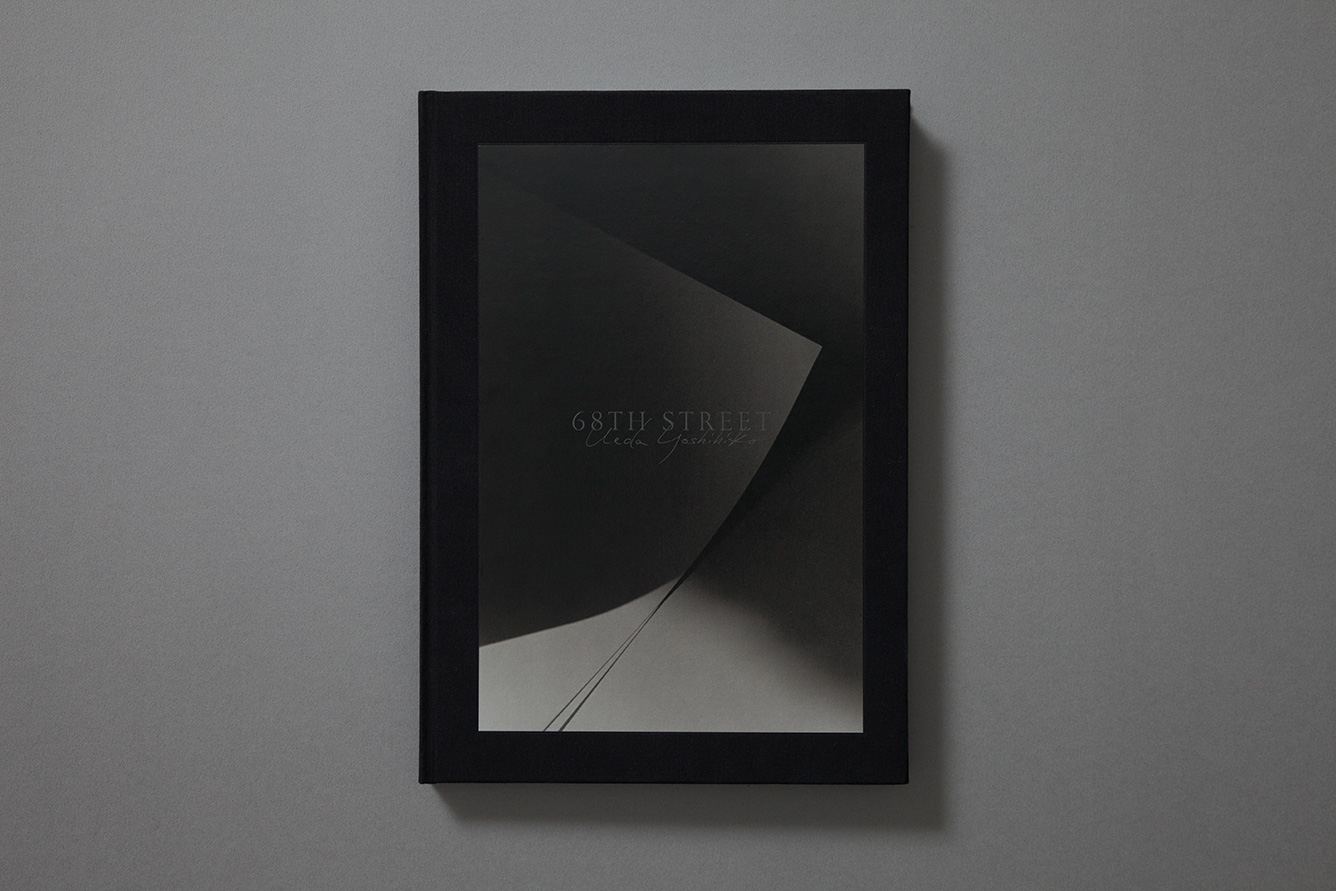
上田義彦写真展「68th Street 光の記憶」の開催に併せ、『68TH STREET』を出版致します。
一枚の白い紙をモチーフに、ニューヨーク68丁目の部屋の窓から落ちてくる、移ろい、刻々とその姿を変える光を追いかけ、上田にとっても命題であった写真の宿命である光とそれによって生まれる影を、モノクロームの印画紙に定着させた。
その深淵な「光と影」の写真群が、撮影後すぐにニューヨークで、旧知のアートディレクターであるファビアン・バロンに託され、撮影された時間軸をそのままに、光の軌跡として刻印された珠玉の一冊。
上田とファビアン・バロンは、雑誌「Visionaire」以来、実に25年ぶりの共演となる。
『68TH STREET』 ご購入をご希望の方は、当ギャラリーまでご連絡ください。
916Press & United Vagaboneds / 360 x 254 mm / 140 pages / 64 photos / 2018年4月出版
¥10,800(税込)
To coincide with the opening of Yoshihiko Ueda's photography exhibition “68th Street: Memories of Light” the photography book 68TH STREET is now available.
68th Street: Memories of Light captures on monochrome photographic paper the light that is photography’s destiny, and was Ueda’s challenge, as he followed—his motif a single sheet of white paper—light falling from the window of his room on New York’s 68th Street—waxing and waning, changing in form from moment to moment—and the shadows this created.
After shooting, these images of fathomless light and shadow were promptly entrusted in New York to art director and old acquaintance Fabien Baron, and assembled into this gem of a book on which the timeline of the shoot is etched in the track of the light. This is in fact the first collaboration between Ueda and Fabien Baron in twenty-five years, since the magazine Visionaire.
published by 916Press & United Vagabonds / 360 x 254 mm / 140 pages / 64 Photos / published in April 2018
¥10,800(with Tax)
overview
68th Street 光の記憶
上田義彦
会期
: 4月21日土曜日 - 5月20日日曜日
開館時間
: 平日 11:00 - 20:00 / 土日・祝日 11:00 - 18:30
定休
: 月曜日(祝日を除く)
入場料
: 一般 800円、大学生・シニア(60歳以上) 500円
高校生 300円、中学生以下無料(Gallery916及び916small)
トークセッション & ブックサイニング :
4月21日(土) 15:00 - 16:30 上田義彦×清水穣(美術評論家)
4月28日(土) 15:00 - 16:30 上田義彦×菅付雅信(編集者)
—光の記憶— 演奏会 :
4月21日(土) 18:30 - 20:30
コントラバス奏者 : 松永誠剛(音楽家)
企画 : Homenaje Project 実行委員会
作品のご購入に関してはギャラリーにお問い合わせください。
MAIL:
mail[a]gallery916.com
68th Street: Memories of Light
Yoshihiko Ueda
Date
: 21 April - 20 May, 2018
Time
: Weekdays 11:00 - 20:00 / Weekends and Holidays 11:00 - 18:30
Closed
: Mondays ( Except for Holidays)
Entrance Fee
:
Adults 800 yen / College students or over the age of 60 500 yen / High school students 300 yen / Junior high school students or younger Free (Gallery916 & 916small)
Talk Session & Book Signing :
21 April, Saturday 15:00 - 16:30 Yoshihiko Ueda, Minoru Shimizu (Art critic)
28 April, Saturday 15:00 - 16:30 Yoshihiko Ueda, Masanobu Sugatsuke (Editor)
ーMemories of Lightー concert :
21 April, Saturday 18:30 - 20:30
Contrabass player : Seigo Matsunaga(Musician)
Planned by : Homenaje Project Executive Committee
Yoshihiko Ueda, the photographs
For enquiries regarding
the purchase of the photographs,
please contact the gallery.
MAIL:
mail[a]gallery916.com
© Gallery 916

